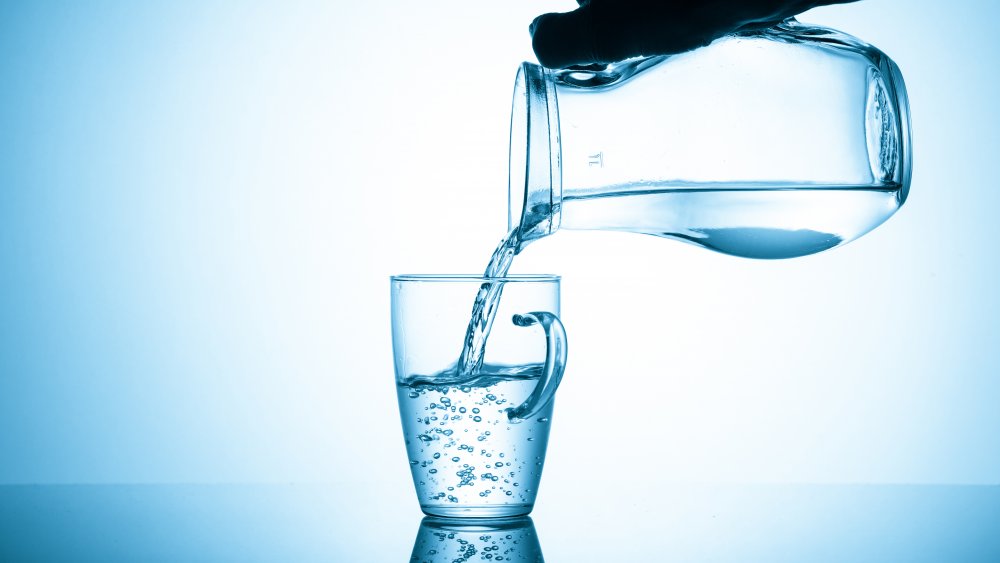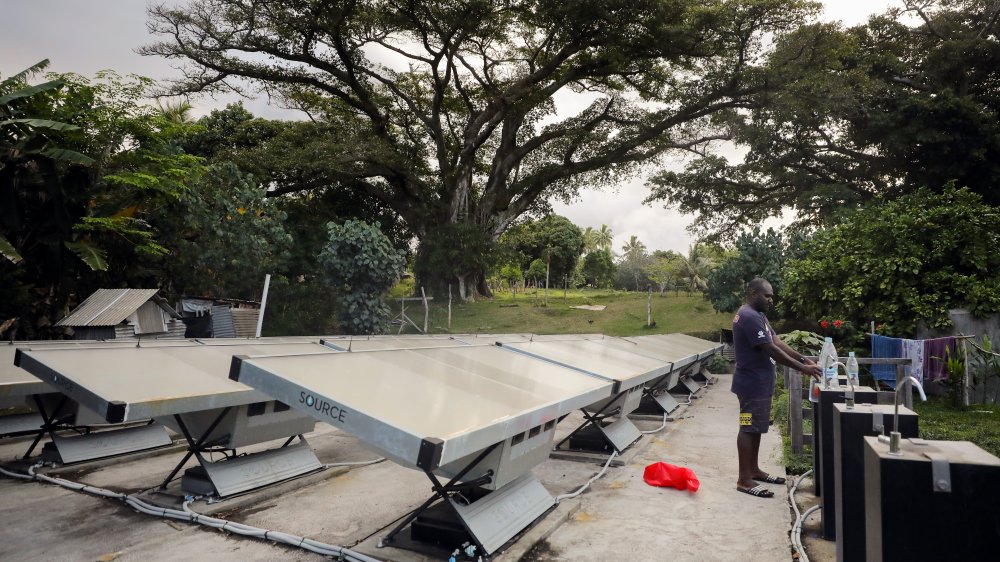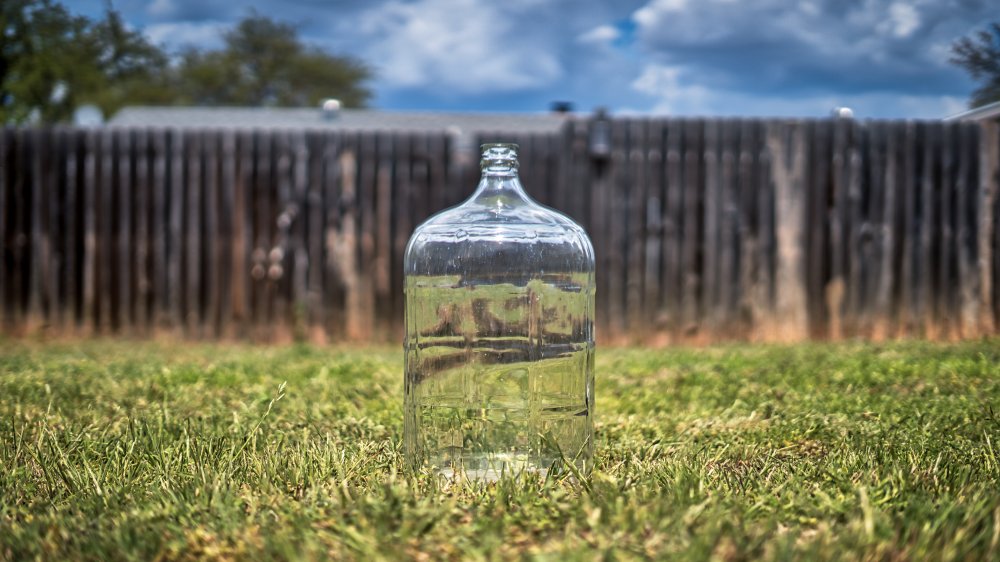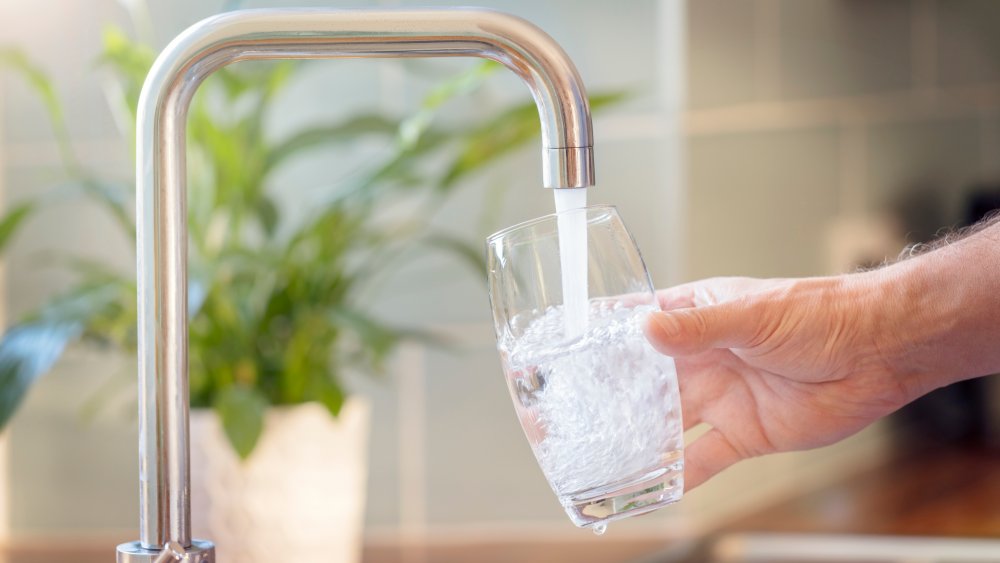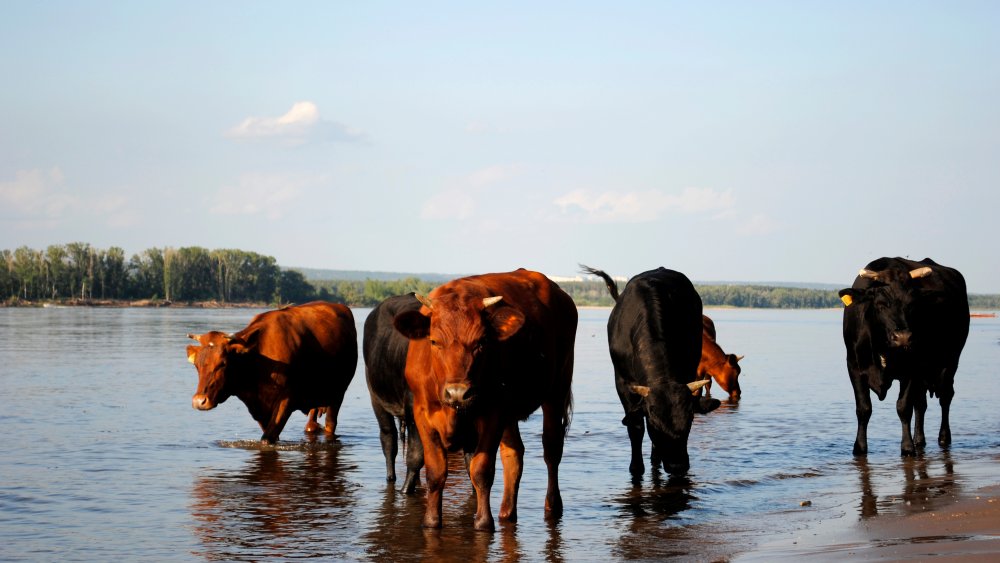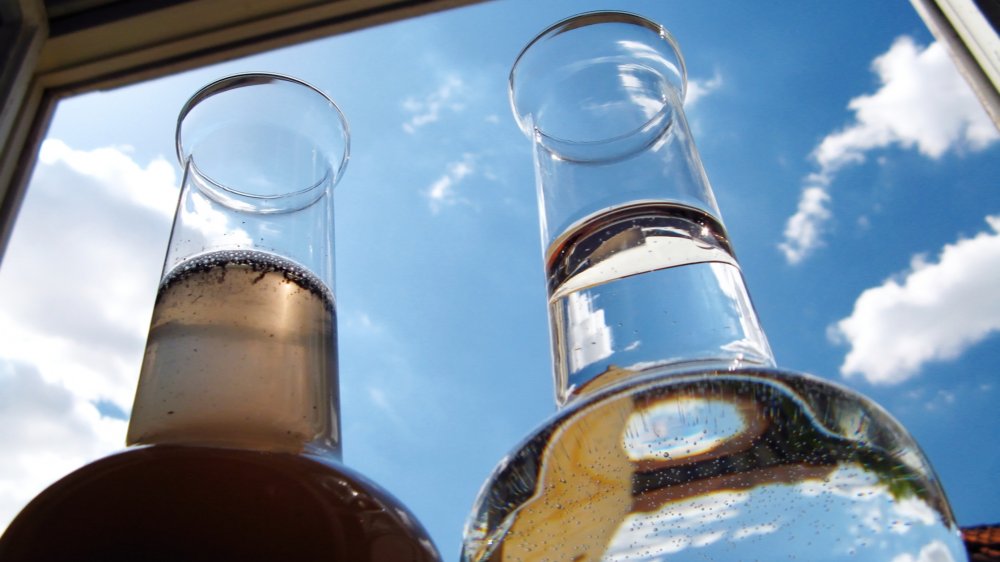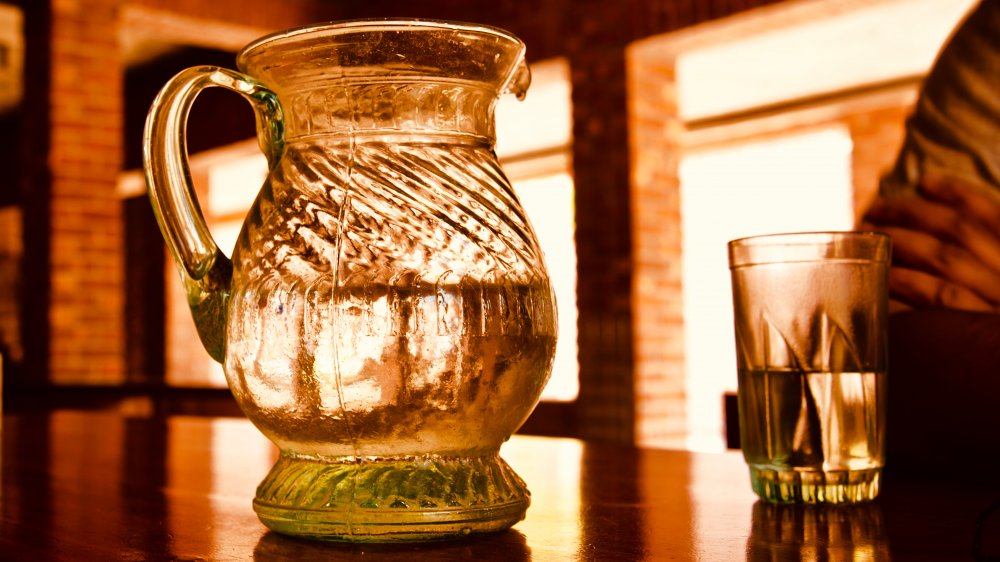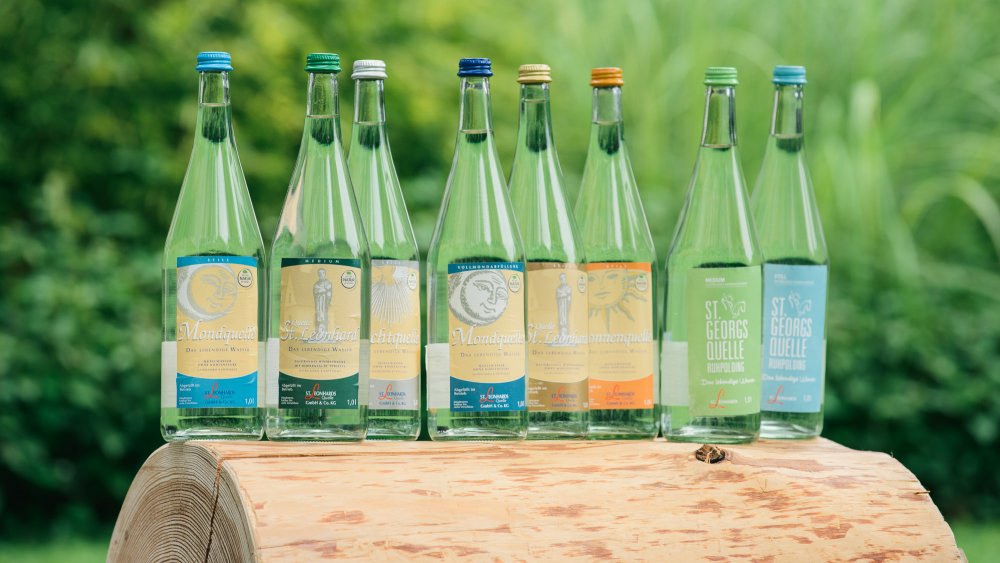The Untold Truth Of Raw Water
New food trends are popping up all the time, and while some will continue to bring back fond childhood memories for decades (Funfetti and Bubble Tape, anyone?) and others will slowly transition into being mainstream (like buying organic and gluten-free), others... well, they're just downright odd.
Remember when we went through that phase of adding activated charcoal to everything? Or when we thought it was a good idea to make milkshakes with everything but the kitchen sink? Yeah. In 2018, there was a new trend that the mainstream market was suddenly taking notice of, and that was the raw water trend that had first started in (then took over) Silicon Valley.
Raw water became a buzzword and when comedians got a hold of the idea, it became something of a punchline. But raw water is not only still around — some raw water companies are absolutely thriving. Is this going to be the next food trend to stop being trendy and start being mainstream? Or is it going to fall by the wayside, too? And what the heck is raw water, anyway?
Support from Silicon Valley made raw water huge
So, what is it? Basically, raw water is water that's sourced from natural springs, bottled, and sold to the customer — without being filtered, sterilized, or treated in any way. It's basically the same water we were drinking a few thousands years ago, and... well, that's both the attraction and the problem.
According to The New York Times, the recent raw water movement started with the ultra-health-conscious tech gurus of Silicon Valley. Particularly, they say one of the most vocal supporters is Doug Evans, the entrepreneur behind the now-defunct juicing company Juicero. Back in the days before he could easily source it, he and friends would go "spring-hunting" — usually at night, and usually travelling through property that wasn't theirs. They took 50 gallons of their spring water to Burning Man, and as you might guess, it was a huge hit.
"I'm extreme about health, I know," Evans says."But I know I'm not alone in this. There are a lot of people doing this with me. You never know who you'll run into at the spring."
After his company Juicero collapsed, he went on a 10-day cleanse where he had nothing but raw water from the Oregon start-up Live Water (and no, we do not recommend doing this). He claimed it was life-changing. Live Water is much more widely available than it used to be, along with raw water from other sources and stores like Liquid Eden and Tourmaline Spring.
Raw water is not all about water sourced from streams
While most raw water is sourced from streams and springs, that's only part of the story. Take a look at Zero Mass Water, a Berkeley, California-based startup headed by an Arizona State University professor named Cody Friesen. Friesen's company is marketing a system called Source, which essentially collects moisture right from the air. This water is filtered, condensed, and stored, and it can produce about 10 liters a day.
According to The New York Times, the whole system will set you back around $4,500, and just a few months after he started taking orders, he had already raised around $24 million in venture capital. Among the first to get a system was Skip Battle — that's not exactly a household name, but the companies he's on the board of are: Netflix, LinkedIn, and OpenTable.
Friesen says the ultimate goal is to allow people a way to get water "that's ultra high quality and secure, totally disconnected from all infrastructure." He's troubled by the fact that the government brings water into homes across the country, and believes that people should own their water in the same way they own their air. After, of course, the initial investment.
Raw water can expire and die
While the water system from Zero Mass Water includes a filtration capability, other raw water proponents believe that's defeating the entire point. Just take the teachings of Mukhande Singh (ne Christopher Sanborn), the founder of Live Water. He says (via The New York Times) that the goal isn't perfect water. "You're going to get 99 percent of the bad stuff out, but now you have dead water," he explains.
According to Singh, when you filter out everything in water, you're essentially killing it. He's very vocal about how you can tell if you have dead water, but only when you compare it to his raw water. He says of raw water:
"It stays most fresh within one lunar cycle of delivery. If it sits around too long, it'll turn green. People don't even realize that because all their water's dead, so they never see it turn green."
Yum? And he's not the only one that touts raw water as "living" water — Tourmaline Spring calls their products "sacred living" water, and according to CEO Seth Pruzansky, "The natural food industry has been in the dark ages when it comes to water. Now, there is a renaissance."
Raw water is part of the "water consciousness movement"
Because every good food trend needs trendy buzzwords, The New York Times reports that raw water is a part of the "water consciousness movement." That implies people are becoming more and more aware of what's in their water, so exactly what do proponents think about raw water?
According to Healthline, those who buy into the movement believe that raw water contains more nutrients and minerals than tap water, and also believe that raw water is more alkaline, giving it anti-aging, anti-cancer, colon-cleansing properties. They also point to the belief it contains all kinds of probiotics, similar to something like yogurt. So is any of that true?
For starters, water generally isn't where humans get most of their vitamins, minerals, and nutrition from — that's not what water is for. There's also plenty of scientific evidence that shows no matter what the pH level of your water is, your body regulates its own pH levels — regardless of how alkaline or acidic your drinks are. And probiotics? Oh, there's definitely bacteria in that water, but there's a hugely important distinction that you have to make between good and bad bacteria. It's the minor details that'll get you every time.
There are some weird conspiracy theories about public water
Raw water isn't just popular because of what's in it, it's popular because of what people believe isn't in it... and here's where we start getting into conspiracy theory territory.
Literally. Timothy Caulfield, the Canada Research Chair in Health, Law, and Policy at the University of Alberta, says (via NBC News) that one of the main reasons proponents of raw water are going this way is because of a belief there's something bad or unhealthy in the water that comes through the tap. Among the most widely condemned substances is fluoride, and the anti-fluoridation movement is nothing new. It actually goes back to the 1950s, with the emergence of a conspiracy theory that claimed the move to add fluoride to water was actually a communist plot, undertaken by shady people who wanted to dose Americans with something that would make them dumber.
At the heart of the movement is the unerring belief that things that are "natural" — like untreated water — are good for you, and unnatural things are bad... in spite of the fact that there are plenty of natural things out there that will happily kill you.
There's actually a term for what's going on here: it's scienceploitation, and it refers to an increasing trend in using science-y language to promote something as being good... even without any actual scientific evidence.
Raw water has shocked the medical and scientific communities
So what do actual scientists and medical professionals have to say about raw water?
Val Curtis, of the London School of Hygiene and Tropical Medicine told The Telegraph, "We've spent generations of science and effort to try and protect people from drinking raw water. It seems extraordinary that people want to go back to medieval times, when millions of people died from infections that were carried by it." In response to Live Water's claims that raw water can essentially work health miracles, Curtis responded: "We can believe in fairies, too, if we like."
And then there's David Jones, professor of the history of medicine at Harvard Medical School. He told The Washington Post, "... we have an incredibly safe and reliable water supply," and added, "In some respects, the fact that people are worried filtration is removing necessary minerals is really an extreme case of one of these First World problems."
And according to Bryn Mawr College chemistry department chair Michelle Francl, there's only one thing that makes water — which is, after all, defined as hydrogen and oxygen molecules — safe to drink, and that is the fact that it's clean. Food for thought.
Here's exactly what bacteria can be in raw water
Raw water proponents say that the stuff is filled with all kinds of good things, but before you go running off to get some, there's more to the story. It can also be filled with a lot of very, very bad things.
Val Curtis, London School of Hygiene and Tropical Medicine told The Telegraph that there's plenty to worry about. Bird droppings, for instance — even aside from the fact that they're bird droppings — can carry Campylobacter, which causes abdominal pain, diarrhea, and vomiting. The World Health Organization says it's also potentially fatal, and is responsible for the loss of "33 million... healthy life years" each year.
Other common contaminants include Cryptosporidium, which often comes from cattle and causes severe respiratory and gastrointestinal distress (via the Mayo Clinic), and both E. coli and giardiasis, which we're all familiar with from cautionary tales about food poisoning.
There are other, more dangerous things lurking in raw water, too. Lifewater (an organization dedicated to "ending the global water and sanitation crisis," not to be confused with Live Water) says that hundreds of millions of people — who are forced to drink "raw water" still suffer from diseases that sound like they should have been left in the Middle Ages: typhoid fever, cholera, and dysentery.
And it's possible there's even more than bacteria in that jar of raw water
Live Water's Mukhande Singh had this to say (via The New York Times) about public water: "Tap water? You're drinking toilet water with birth control drugs in them. Chloramine, and on top of that they're putting in fluoride. Call me a conspiracy theorist, but it's a mind-control drug that has no benefit to our dental health."
Well, he certainly doesn't pull any punches, but experts say there's much more in raw water that you really should be worried about.
For starters, Forbes points out that the Earth is no longer the clean, pristine planet it once was, and pollutants are everywhere. They can show up anywhere in the water cycle, and that's what filtration and treatment is also protecting us from. Those are things like, well, pretty much any pollutant that can end up in the water: from carcinogenic and man-made compounds to naturally occurring — but still deadly — elements.
What kind of naturally occurring elements? According to the CDC, arsenic commonly leaches into groundwater from naturally occurring deposits, and it's also dumped there after being created as a byproduct from industries like smelting and mining. And yes, that stuff will definitely kill you: in fact, it was a commonly favored poison for some of history's most notorious serial poisoners.
Raw water is ridiculously expensive
Still thinking raw water might be worth the switch? Forbes cautions that if you intend on going all-natural and buying your raw water at the store instead of getting the stuff out of the tap, you should know how much it's going to set you back. On average, a 2.5 gallon jar of raw water runs about $36.99 — so consider that next time you go to put gas in your car.
According to The Guardian, almost no one is happy with the prices some (most) are charging for raw water, and once the idea started to go mainstream, there was quite a lot of bitterness there. Companies that had been around for a long time (like Tourmaline Springs, who started in ye olden times of 2009) were mad that newcomers to the raw water scene were charging so much.
Tourmaline Springs — who sold their raw water at a fairly reasonable $2.99 per liter — condemned the prices charged by Live Water. (Singh claims that although the water actually costs about a penny per gallon, the cost isn't outrageous because of things like bottling, transportation, and that fancy glass jar it comes in. He adds, "Live Water is just priceless, a return to living in harmony and a gift that the earth is offering us."
Tourmaline Springs founder Seth Pruzansky thinks otherwise, saying: "I call them entrepreneurial opportuni-vores. People who see a trend and just want to make money."
Here's how many people die from drinking "raw water"
After hearing so much about raw water as a food trend, it's easy to forget that it's a deadly problem outside of America. According to the World Health Organization, around 2 million people each year die from waterborne illnesses, and most of those are children under 5 years old.
According to UNICEF, more than a billion people on the planet don't have access to safe, treated, and filtered water, and double that don't have adequate sanitation. That's an unthinkably huge number, and to put that in perspective, let's look at the very moment you're reading this. Right now, over half of the people in the developing world are feeling the effects of waterborne illnesses or unsafe sanitation. And they also say that every one of those four billion yearly cases of illness and those more than 2 millions deaths would be preventable with proper water treatment plans and resources... i.e., if they didn't have to drink raw water.
Water sanitation is considered one of the most important advances in public health
It's not just the American government that has stressed the importance of proper, safe drinking water — although "Access to Safe Water and Sanitation" was on the CDC's list of Ten Great Public Health Achievements, along with the control of malaria and tuberculosis.
The United Nations, too, has issued official statements on the importance of clean drinking water. In 2010, a resolution was passed that "declared safe and clean drinking water and sanitation a human right essential to the full enjoyment of life and all other human rights."
And that's a huge deal — it called access to safe drinking water (i.e., not raw water) a "legal entitlement, rather than a commodity or service," and they defined what that water is, too. It's "free from micro-organisms, chemical substances and radiological hazards that constitute a threat to health." ... again, basically not raw water.
That's just one corner of the specialty water market
About the same time raw water showed up on the market, hydrogen water showed up, too. And yes, it's exactly what it sounds like: water with hydrogen added. But, you're saying, isn't the "H" in "H2O" already hydrogen? Yes, but this has extra hydrogen, and according to SELF, believers say that it helps act as an anti-inflammatory, makes your skin glow, and turns your body into "an antioxidant factory." Does it? Science isn't so sure, but most are confident in saying "probably not."
And don't worry, it gets weirder. Mitte says there's a whole belief system that says water has a consciousness — it's this energy (they say) that allowed people to find underground water sources. That's led to the development of companies like St. Leonhards Quellen, a German mineral water company who bottles one type of their water just once a month — during a full moon — in order to capture all the magical energies they can. Another brand of their water is special because it contains all light frequencies, and another contains the sun's energy.
There are also products like the VitaJuwel Gem Water Bottle, which promises to infuse your water with the power of crystals, and the $400 Natural Action Technologies Portable Structured Water Device, which is essentially a funnel you can pour your water through to produce "ever accelerating vortices" that produce "structured water." What does that all mean? Just aw water isn't the only game in town.
